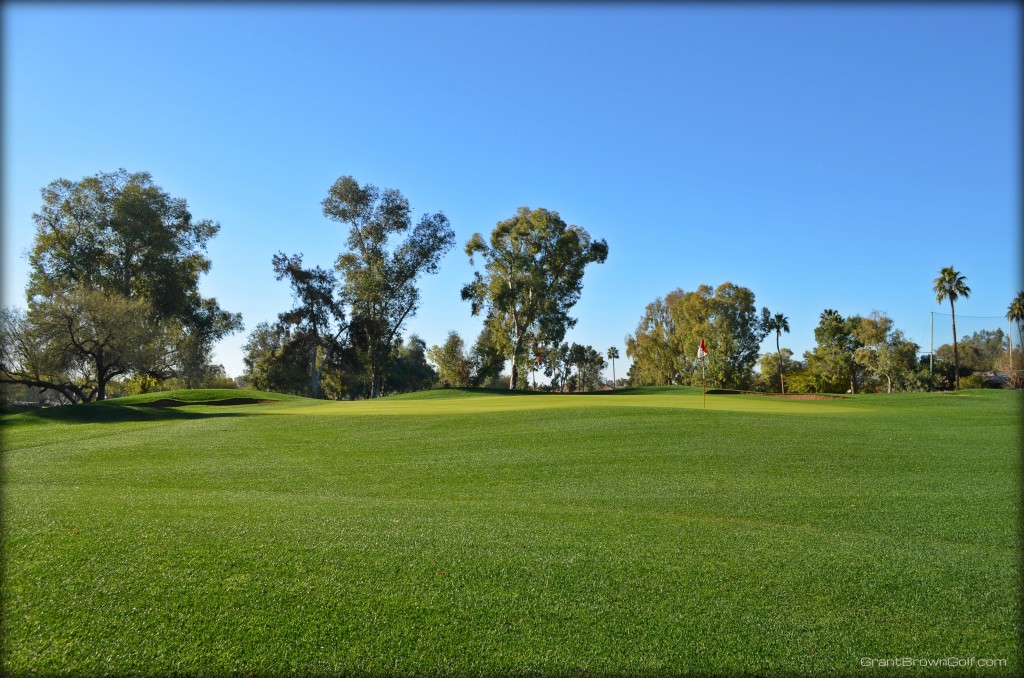-
Reading Greens
Do you have a consistent process for reading greens? Or do you just wait until it is your turn to putt and then hurriedly guess the line and go with it?
Here’s my process for reading greens that has helped me make a lot of putts over the years:
1. Read the slope from a distance: As soon as my ball lands on the green, I start to read the slope with my eyes as I walk toward the green.
 When I am still a long distance from the green it is much easier to see the overall slope of the green.
When I am still a long distance from the green it is much easier to see the overall slope of the green.2. Identify surrounding landmarks: Almost every course has a high point like a mountain or a low point like a river or valley situated near the golf course. When I am walking toward the green, I look at where these landmarks are located in relation to the line of my putt. (If I am putting toward the mountain, my putt will be a little slower than it looks; if I am putting toward a valley, the putt might be a little faster than it looks.)
For example, I play Papago Golf Course in Phoenix quite often. There are mountains situated to the north of the golf course and a valley is to the south. A helpful landmark a few miles south of the golf course is the control tower for Sky Harbor Airport. Before every putt at Papago, I check to see where the control tower is in relation to the line of my putt.
3. Find the low places around the edge of the green: The golf ball will always break from a high point to a low point just like water will always flow from a high point to a lower point. As I am walking toward the green, I can easily see the low points around the edge of the green if I visualize how water would run off the green if it were raining. Usually on each green there are 2 to 4 low places that the water will drain off the green.
 Also, if your ball is sitting close to a greenside bunker you can be sure that the putt will break away from the bunker. This is true because the course architect would not design the green so that water would drain into a greenside bunker.
Also, if your ball is sitting close to a greenside bunker you can be sure that the putt will break away from the bunker. This is true because the course architect would not design the green so that water would drain into a greenside bunker.4. Read the grain of the grass: If I am playing on bermuda grass greens, I always check if I am putting into the grain or with the grain. Putting with the grain will make my putt faster while putting against the grain will make it slower. Also, if the grain is lying perpendicular to your line, the putt will break more in the direction that the grain is pointing.
If the bermuda grass green looks shiny to me, that means the blades of grass are pointing away from me, and I am putting with the grain. If the green looks to be a darker color green, it means that the blades of grass are pointed toward me and I am putting into the the grain.
One other way I check the grain of the bermuda grass is to inspect the grass around the cup. One edge of the cup will be nice and green: This means that the blades of grass are growing over that edge of the cup. The other edge of the cup will be brown: This means that the blades of grass are pointing away from this edge of the cup.
5. Feel the slope with my feet: If I am not totally sure of which way the putt will break after doing the four steps above, I will walk along the line of my putt and feel the slope with my feet. I have learned to trust what my feet feel much more than what my eyes see when I am standing on the putting green.
If you can’t feel which way the ground is sloping with your feet, just shut your eyes: Then you will be able to sense which direction the slope will take your ball.
Have fun reading greens and remember that you can have most of your green reading finished by the time you step onto the green!
GB





